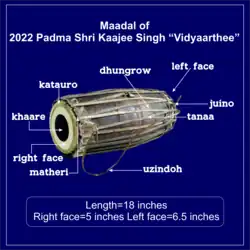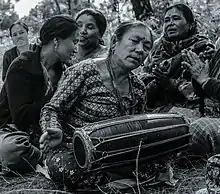Madal
The madal (Nepali: मादल) or maadal is a Nepalese folk musical instrument.[1] The madal is used mainly for rhythm-keeping in Nepalese folk music. It is very popular and widely used as a hand drum in Nepal. The madal has a cylindrical body with a slight bulge at its center and heads at both ends, one head larger than the other. It is usually played horizontally in a seated position, with both heads played simultaneously.
 Nomenclature of Maadal | |
| Percussion instrument | |
|---|---|
| Other names | Mardala, Maadal, Mardal, Madal, Mirdang, Phakawaj, In Pali it is called Maddala. |
| Classification | Membranophone |
| Hornbostel–Sachs classification | 211.252.12 (membranophone--individual double-skin conical drum, both heads played) |
| Inventor(s) | Lord Biswarkarma or Kami (caste) |
| Developed | During Sixth Century |
| Related instruments | |
| Mridangam | |
| Musicians | |
| |
The madal[2] is the national instrument of Nepal and is the backbone of most Nepali folk music.[3] The well-known Nepali musician Ranjit Gazmer introduced this instrument to Bollywood music when he started working under Rahul Dev Burman, and has used it in numerous Bollywood songs such as Hum Dono Do Premi and Kanchi Re Kanchi Re.[4] There is also a madal drum used by certain Adivasi groups.
History and nomenclature
The madal originated in the Magar community of Nepal.[5] And it is believed that the creator of Maadal is given to the Kami (caste) people.
The name of the madal is said to come from that of an earlier instrument, the Mardal which is the Sanskrit name or it can be from the Pali word Maddala, (Nepali: मर्दल), whose name in turn is derived from the mridung, a classical Indian instrument. In the Palpa district of Nepal, it is known as rāni mādal (Nepali: रानी मादल, lit. 'queen madal'). In the Nepalbhasa (Newar) language in the Kathmandu Valley, it's called the maga khĩ (Newar: मग खिँ) in reference to the Magar people.[6]
Construction

Typically, a wooden log is carved so as to form a hollow cavity, called ghar (Nepali: घर). The heads of the drum are made of double-layered goat skins, and a black paste made of flour, iron filings, and egg is burned into a circular area in the centre of each head. This circle adds weight to the head and significantly alters the sound of the drum, giving it a bell-like quality. The heads are fixed to the body of the drum by leather strips running the length of the body, and an additional loose strip of leather that can be looped behind the performer's knees while playing The larger and smaller heads are often referred to as male and female respectively.[7][8]
Similarities

Similar instruments called modal or mondal are found throughout the Central India and Bangladesh.[9] The Bodo also use a very similiar albeit larger version of the instrument which they call kham.
See also
References
- Vetter, Roger. "mādal · Grinnell College Musical Instrument Collection · Grinnell College Libraries". omeka-s.grinnell.edu. Retrieved 2022-02-18.
- Poudel, Parsuram Prasad (31 December 2021). "History of Madal". Journal of Fine Arts Campus. 3 (2): 23–32. doi:10.3126/jfac.v3i2.48332. S2CID 252269213. Retrieved 2023-01-18.
- "Madal Folk Instrument of Nepal". ECS NEPAL. Retrieved 2022-02-18.
- Gaekwad, Manish (2018-03-17). "R.D. Burman's percussionist Ranjit Gazmer is a symbol of the old days of Bollywood composition". The Hindu. ISSN 0971-751X. Retrieved 2022-02-18.
- {cite.book|last=Darnāla|first=Rāmaśaraṇa|title=Nepālī bājā|year=2004|publisher=Ratna Pustaka Bhaṇḍāra|location=Kāṭhamāḍauṃ|isbn=99933-0-463-8|edition=1. saṃskaraṇa.}}
- कार्की, पदमसिंह (2016-09-15). "मादल महात्म्य". nepalmag.com.np. Retrieved 2022-02-18.
- "Nepalese Madal". rhythmuseum.com. Archived from the original on 2012-03-27. Retrieved 2011-07-16.
- Kan̐ḍela, Rāmaprasāda (2004). Nepālī lokabājā (Saṃskaraṇa. 1. ed.). Kāṭhamāḍauṃ: Nepālī Lokabājā Saṅgrahālaya. ISBN 99933-877-3-8.
- "What is Nepali Music?". Himal Southasian. 1993-11-01. Retrieved 2022-02-18.
Notes
- Anmol, Amrita Priyamvada (2009). Encyclopaedia of Indian Musical Instruments, vols. 1 to 3 :, xxxvi, 720 p, 3 vols, figs, ISBN 9788126140770
- L.S. Rajagopalan, L.S. in A. Purushothaman and A. Harindranath (eds) (2010). Temple Musical Instruments of Kerala. Sangeet Natak Akademi, xvi, 168 p, ISBN 8124605440